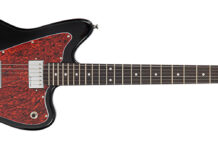Warning: Seriously Scary Scale Knowledge
One question that comes up consistently from my students is, “How do I develop the ability to play long phrases at mind-numbing tempos and increase my understanding of the fretboard?”
My usual response is, “Learn your scales and start a romantic affair with your metronome.”
But today I will go much more in depth and offer an organized approach to cultivating some seriously scary scale knowledge.
SEQUENCES
The first thing to do after any scale has been learned on the fingerboard is to start to sequence the hell out of it. Most of us know the harmonic minor scales formula is 1-2-b3-4-5-b6-7, but how many players take the time to create different melodic patterns and create sequences intervallically or numerically?
Sequences can be made by skipping notes in the scale at a predetermined interval, such as diatonic seconds, thirds, fourths, fifths, sixths, sevenths and octaves. Another more common way to sequence a scale is to use a specific numeric set of notes.
For example, in A harmonic minor, you play the notes A, B and C after that set of three notes is played you begin the next sequence on B and continue ascending to the note E, etc. Sequencing all your known scales in position via CAGED and horizontally across the neck will prove to be challenging, but the benefits of mapping out the fingerboard and increasing your ability to create licks and connect phrases will soar to new heights.
SUBDIVIDE
Another way to get a strong grip on those pesky scales is to practice them rhythmically. While I was studying at G.I.T., my favorite teacher (See my last column) showed me a really cool and tricky exercise to greatly increase dexterity and mastery of scales. Take any scale and get your metronome clicking to a humble pace, then play one measure of quarter notes, followed by a measure each of eighths, eighth note triplets, sixteenths and back down systematically. Focus on rhythmic accuracy and even tone.
The cool thing about this exercise is that it forces you to know your scales inside and out because you are constantly shifting where the one is in regards to the scale. For you more advanced players, try starting with quarter notes working your way up through quintuplets, sextuplets, septuplets and 32nd notes and all the way back down! If you can accurately subdivide the beat in a flash, that will lead to much more interesting lines.
CONNECT THE DOTS
Now you have the awesome sequences down and the rhythmic precision of Ron Jeremy! What next?
It might be time for you to start combining all this information over some actual chord progressions. I practice this task by playing “The Connecting Game.” This game is played by picking a few different chord progressions varying in tempo and difficulty and picking a steady stream of notes in a particular rhythm (eighths, sixteenths, septuplets, etc.) while moving across the neck and in position without missing a beat.
Notes can be doubled, and brilliant playing is not necessary. The chord progression is played for a preset amount of time and stopped promptly after. Rest is important between chord progressions in order to give the mind and hands a sense of calm before tackling the next chord progression. Good luck!
Shawn McGovern is a GIT graduate and sought-out guitar instructor in Providence, Rhode Island, and Los Angeles and may be contacted through his site, shawnmcgovern.com.
Source: www.guitarworld.com









